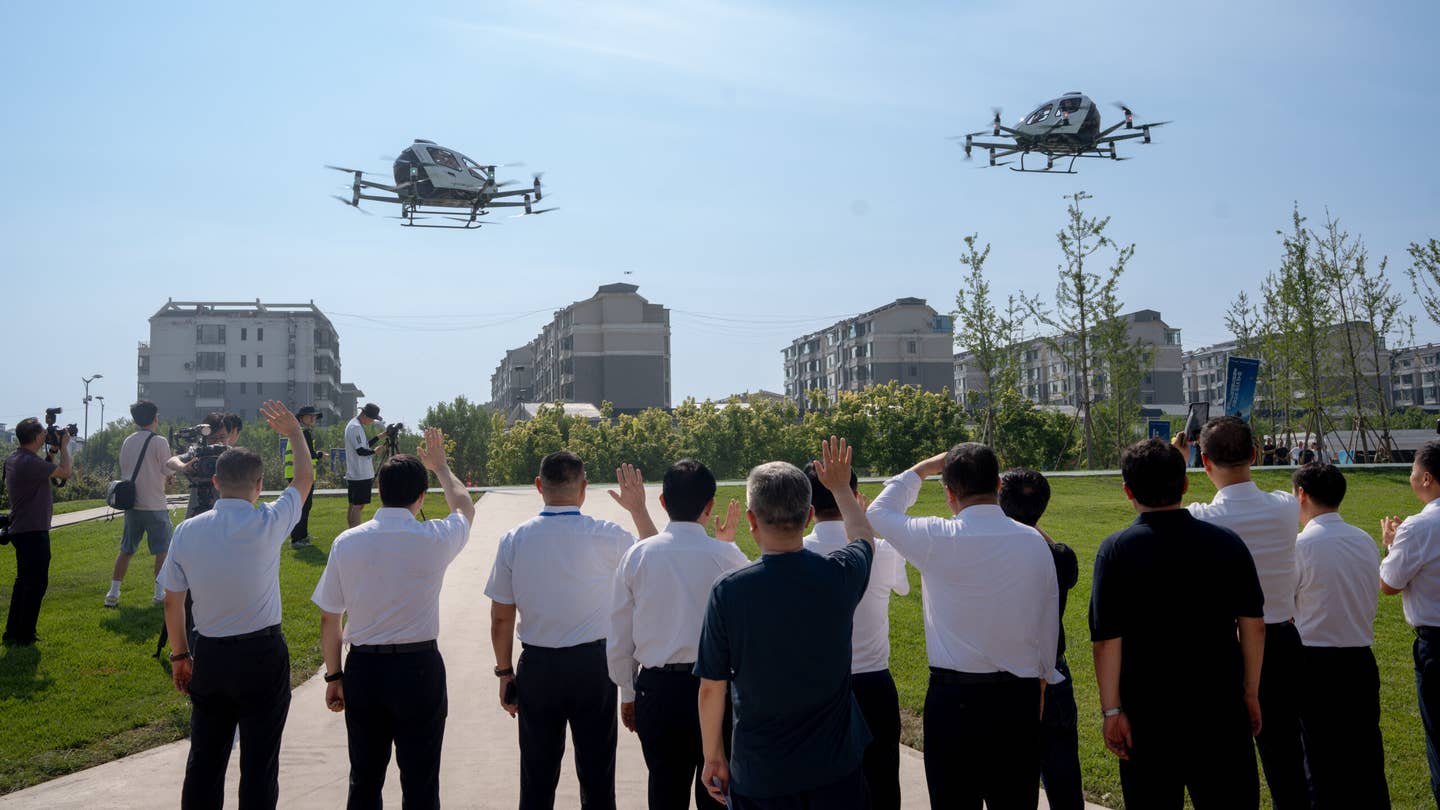EHang Completes More Passenger-Carrying eVTOL Flights in China
The Chinese electric vertical takeoff and landing air taxi manufacturer delivers five aircraft to Xishan Tourism.

Two of EHang’s self-flying EH216-S air taxis lift off together from Paddy Field Park in Taiyuan, Shanxi, China. [Courtesy: EHang]
Chinese electric vertical takeoff and landing (eVTOL) air taxi manufacturer EHang is taking to the skies of inland China.
After completing the world's first electric air taxi flights in Guangzhou and Hefei in December, EHang on Sunday made debut passenger carrying flights in the city of Taiyuan.
The trips, completed using EHang’s self-flying EH216-S air taxi, follow the company’s delivery of 10 aircraft to Xishan Tourism, which in May signed a purchase order for 50 units. The companies have a tentative agreement for EHang to deliver 450 aircraft over the next two years, with an eye toward launching aerial tourism and sightseeing services across North China.
“We have gradually delivered EH216-S by batches to Taiyuan, Hefei, Wuxi, Wencheng, Zhuhai, and other places, and are actively assisting our local partners who are creating application scenarios to obtain [air operator certification],” said Zhao Wang, chief operating officer of EHang.
EHang received its own air operator certificate last week from China’s Civil Aviation Authority (CAAC).
The province of Shanxi, in which Taiyuan is located, has been designated by the Chinese government as a national demonstration province for the country’s low-altitude economy, an analog to the advanced air mobility (AAM) industry forming in the U.S. and elsewhere. Taiyuan is the region’s capital and largest city and is considered a political and economic center.
The measure subsidizes regular, low-altitude tourism flights in the region, as well as the construction of infrastructure and other capabilities needed for routine service.
“Taiyuan is a national civil unmanned aerial vehicle test zone, with the foundation and advantages to develop the aviation industry, and will actively seize the lead in the emerging low-altitude economy industry,” said Jicheng Yang, executive vice mayor of Taiyuan and a member of the city’s municipal committee. “Taiyuan will enhance policy support, essential guarantees, and innovation capabilities, and promote the deep integration of technological innovation and the low-altitude economy.”
Xishan Tourism plans to use the designation to launch low-altitude sightseeing and tourism routes to local sites such as Yuquan Mountain, Paddy Field Park, and Juewei Mountain.
On Sunday, two EH216-S aircraft, carrying two passengers each, took off and flew autonomously from Paddy Field Park in a ceremony attended by regional government officials and industry experts. Two of the passengers were officials within the newly formed Taiyuan Xishan Ecological Tourism Demonstration Zone.
Xishan Tourism, though, said it is still working toward “regular operation”—in other words, the flights are not yet routine, as is the case in Guangzhou and Hefei.
“Xishan Tourism plans to collaborate with EHang and other partners on low-altitude scenarios of air mobility, tourism, and public services to establish multiple flight camps or landing pads, alongside various low-altitude sightseeing routes for pilotless eVTOL within Taiyuan and nearby scenic areas,” said Yaozong Chang, chairman of Xishan Tourism. “We aim to build an urban low-altitude tourism mobility network and a new urban air traffic management system, and to establish a low-altitude economy industrial park.”
EHang at the event also demonstrated its longer-range, passenger-carrying VT-30, firefighting EH216-F, and EH216-L for cargo logistics.
All four aircraft were on display in the Middle East in May, when the manufacturer completed that region’s first passenger carrying eVTOL flights in the United Arab Emirates.
The company’s flagship EH216-S is the first and only eVTOL design to receive type certification from a national aviation regulator, the CAAC. The regulator in December also handed the EH216-S the world’s first eVTOL airworthiness certification and in April gave the green light for EHang to begin mass manufacturing the model.
That puts the company well ahead of competitors in the U.S. such as Archer Aviation and Joby Aviation, which are building piloted air taxis but have yet to obtain any of those three approvals. Both companies are targeting commercial rollouts in 2025.
Like EHang, Boeing air taxi subsidiary Wisk Aero is building a self-flying design but does not expect it to fly commercially until the end of the decade.
Like this story? We think you'll also like the Future of FLYING newsletter sent every Thursday afternoon. Sign up now.

Sign-up for newsletters & special offers!
Get the latest FLYING stories & special offers delivered directly to your inbox






